It felt good to be back in Amman. As I had planned, now, at the end of my journey around Jordan, I spent two nights here with a free day in between, while on the last day I had to go to the airport right after the breakfast.
To start with, the first morning I met again with Farida, a woman working at the hotel who was, among other things, in charge of organising the breakfast. It was a very cordial encounter, so much so that we hugged and kissed each other. After the breakfast, I sat at her table and had Turkish coffee with her. Then we also agreed that we would meet later during the day so that she could help me out with some shopping close to the hotel. The arrangement was that I should first go for my sightseeing and when I got back and she finished with her work and obligations at the hotel, we would go together so that I could buy a few small gifts.
Then I walked to the Jordan Museum. There was still some snow to be seen in the streets, but although the weather forecast said it may rain during the morning, it was just cloudy. However, the clouds dispersed to a large degree later on.
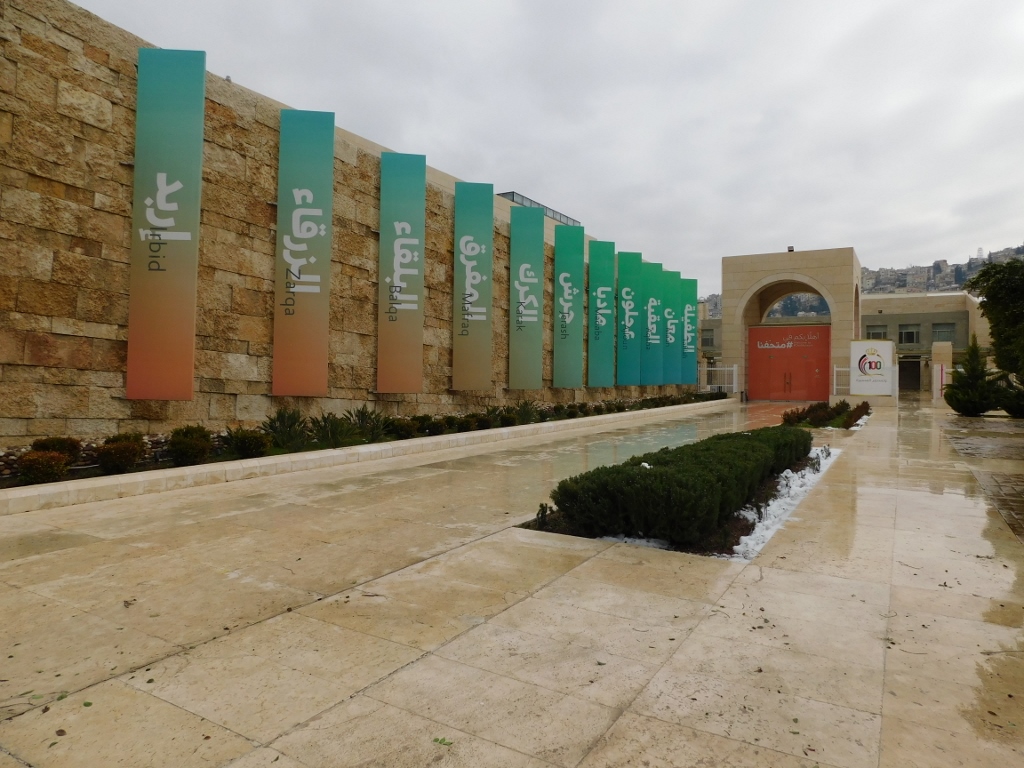 The Jordan Museum
The Jordan Museum
The Jordan Museum is the biggest museum in the country and it is placed in a brand new building (it was built in 2014). The museum is not particularly big, but it is extremely nicely and interestingly organised. There, in one place, you can see an overview of the impressive history on the territory of the present-day Jordan (from prehistory to the recent events). I usually take photos when visiting museums and then I include some of these photos in my travel stories, but I don’t have a single interesting photograph from here. This only goes to show the psychological and physical state of being that characterised the end of my journey.
Still, I do have a photograph that is especially interesting and that I took upon my return home! In the part of the museum where the development of different scripts is shown, there is even an interactive point where the visitors may write down their name in the Latin script and then get a printed form showing how that same name would be written in the Aramaic, Nabataean, Greek and Arabic languages. I must admit I would have skipped this for sure (I would not have noticed it), had I not seen a lady who was just printing her paper and then she helped me out with the use of this interactive device. I found it very interesting. Here is the picture of the printed result:
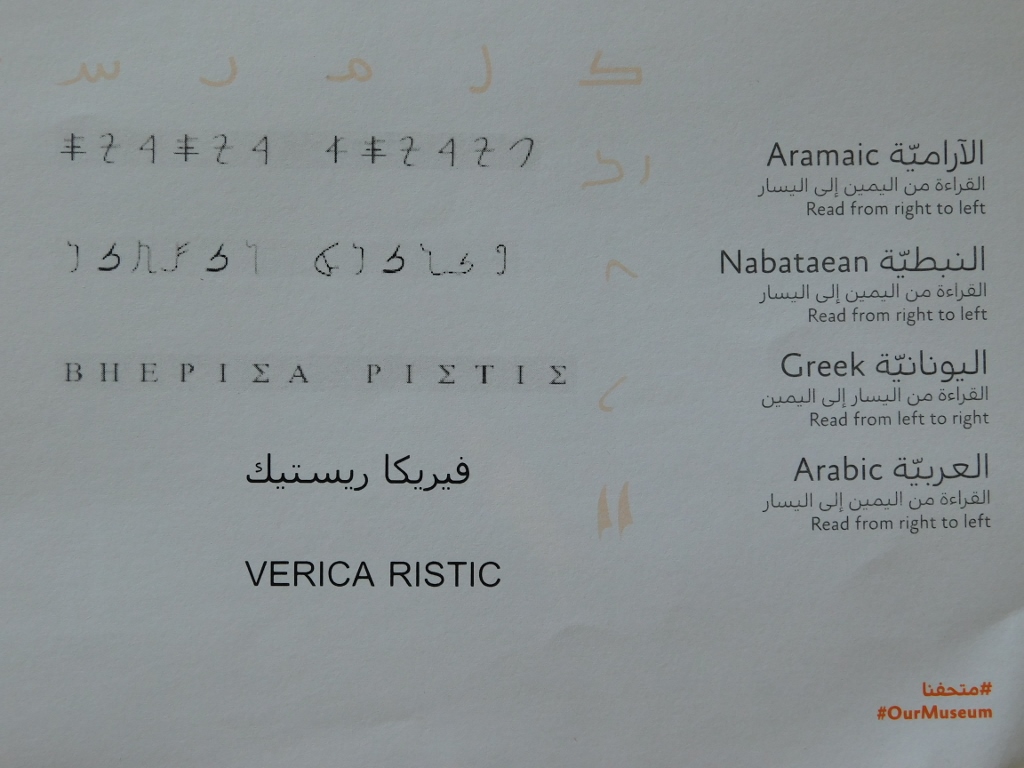 My name written in different scripts (by the way, here is the Cyrillic version: Верица Ристић)
My name written in different scripts (by the way, here is the Cyrillic version: Верица Ристић)
The museum also has a small display dealing with the Dead Sea Scrolls. Namely, in the period from 1947 until 1956, a myriad of documents on parchment and papyrus, and only one on copper sheet, were found northwest of the Dead Sea (this was on the West Bank which was a part of the Kingdom of Jordan at the time). The documents come from the period from the 3rd century BCE to the 1st century CE. They were found by a Palestinian shepherd who then sold seven pieces to antiquities dealers. Some were smuggled out of the country, while others were purchased and can be seen at a museum in West Jerusalem.
Later the official researchers started with the quest, they located the caves and thus, over time, pieces of 900 documents were discovered. Of course, owing to the turbulent events in this region in the second half of the 20th century, most of the scrolls ended up at the museum in Israel. Here, in the Jordan Museum, you can see that only scroll found on copper sheet.
When I finished with my visit to the museum, I got a taxi I went to Abdali Mall. Abdali is a part of Amman and mall is a mall. There were two reasons for my visit to the mall. The first one was that it was easy to say it to the taxi driver. The second reason was that, traditionally, I like very much to buy small items in supermarkets and there was a large supermarket here. And so, firm in my intent to make some Jordanian sweets when I go back home, I found a spice here that was not easy to find in some other places (mahlab). I also came across a nice pack of the best quality dates, medjool dates, on sale. I love dates and never miss an opportunity!
Then I went to have coffee in one of those typical cafés which are a regular feature of malls and that was essentially very stupid on my part. The young man working there did not listen at all to what I was telling him, the coffee was of mediocre quality and by its price certainly overrated, as is the custom in such “polished” places where people like to go because they think of such places as elegant and consequently have a better opinion of themselves. A little later, I had freshly squeezed juice of two oranges and a Japanese apple – in terms of the quantity, there was at least 20 times more liquid than coffee, in terms of the price, the juice was half the price of the coffee, and in terms of the quality, the juice was incomparably better than the coffee. And as for my opinion about myself, when later I had the juice while sitting on a plastic chair, out in the open, on the pavement in front of the juice shop, the juice that would not shame even the gods – I had a very high opinion of myself and my readiness to enjoy the joys of this life, irrespective of the modest appearance of the venue where I was.
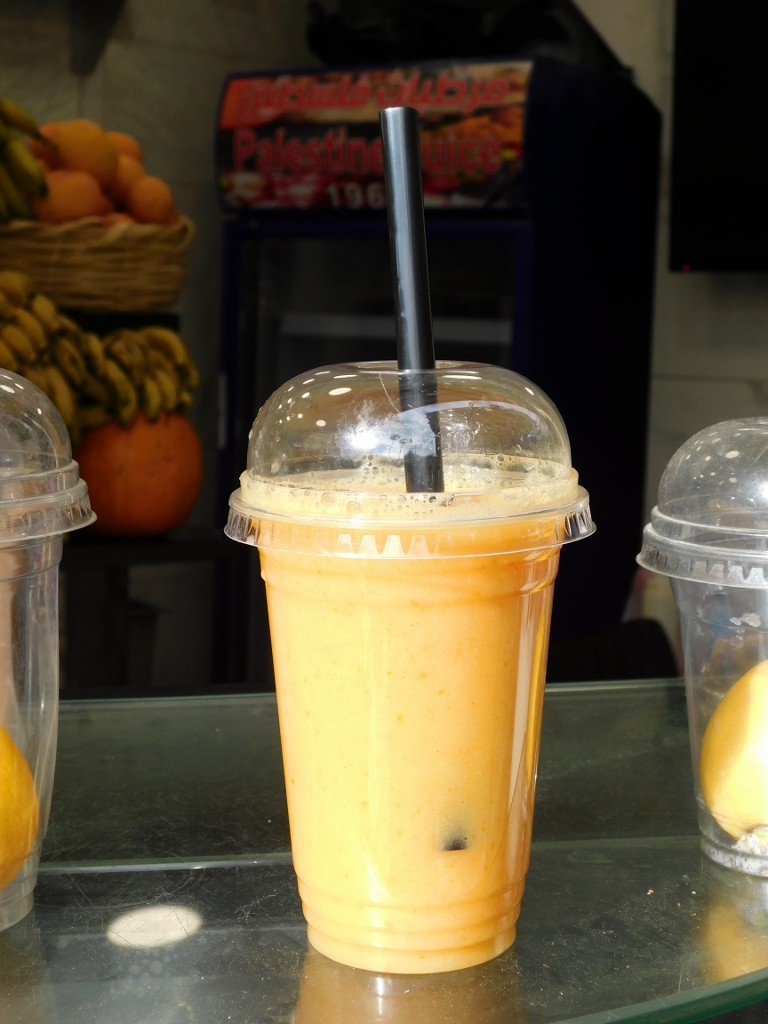 Ultimate drink that could easily be the nectar of the gods
Ultimate drink that could easily be the nectar of the gods
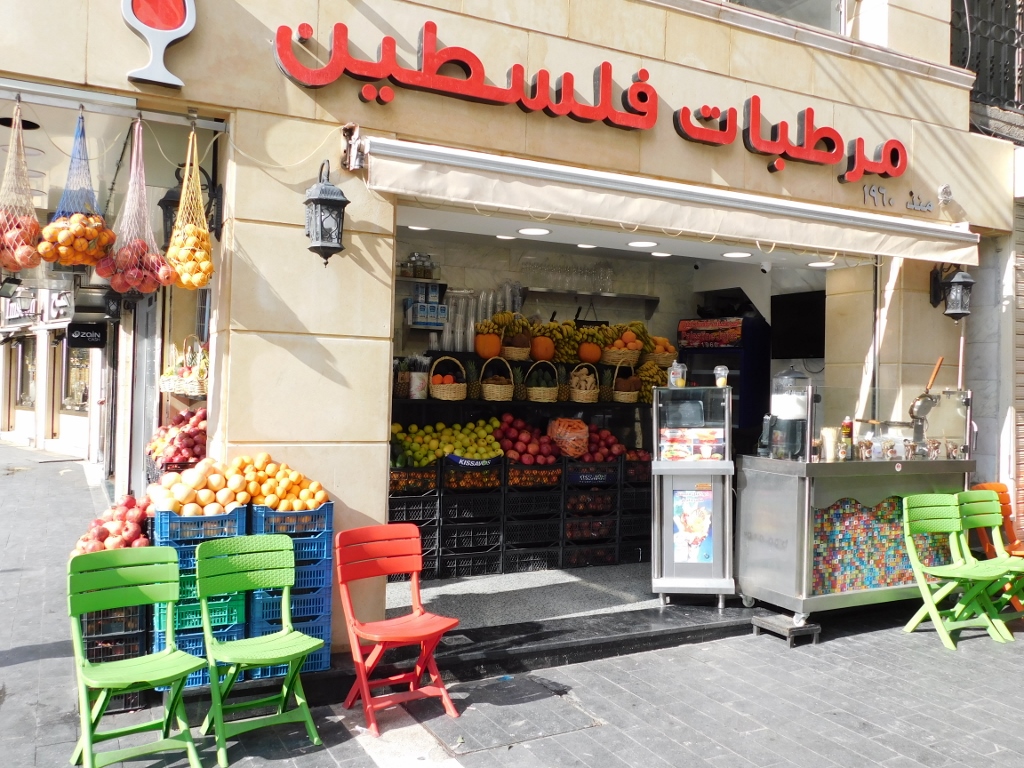 One of the many places in Jordan where freshly squeezed juices can be bought and drunk
One of the many places in Jordan where freshly squeezed juices can be bought and drunk
But, let me go back to the part of Amman called Al Abdali. Not far from this mall there is the Palace of Justice, as well as the Parliament building.
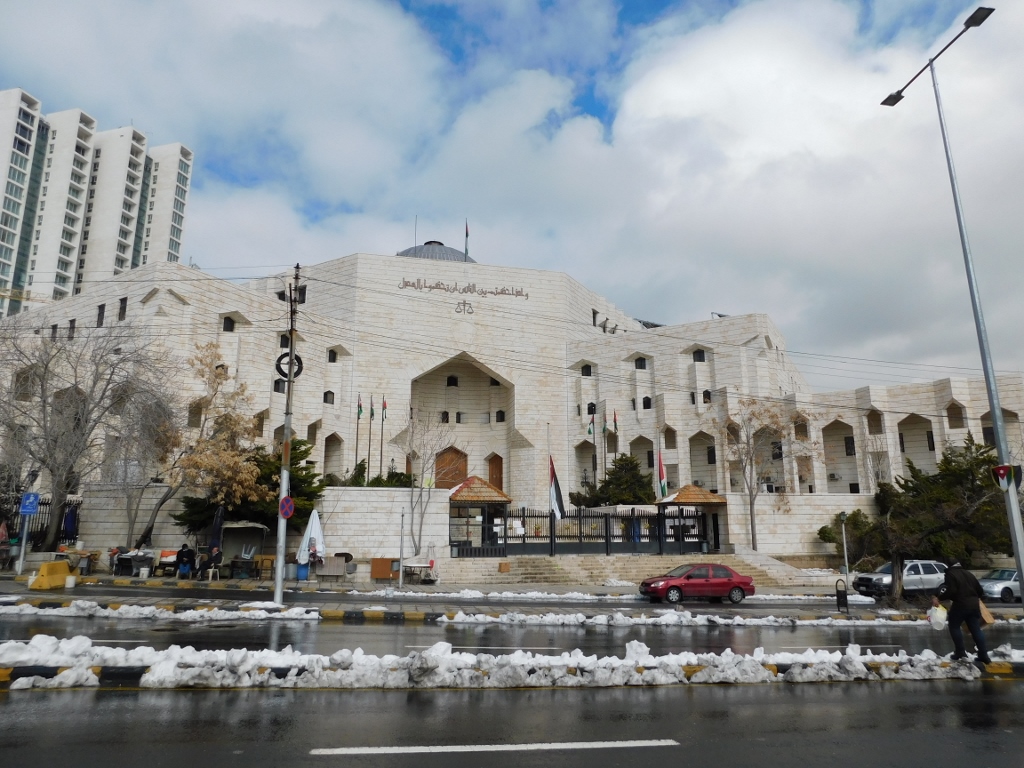 Palace of Justice
Palace of Justice
There was still some snow in the streets, but it was thawing quickly. Since all of Amman consists of hills and valleys, streams of thawed snow flowed along the streets, so I was careful about where I was stepping. This was not any deep water, but I presumed that in combination with snow it could get slippery. It all went perfectly well and so I reached the King Abdullah I Mosque that some people call Amman’s Blue Mosque. When you see it, it becomes clear why.
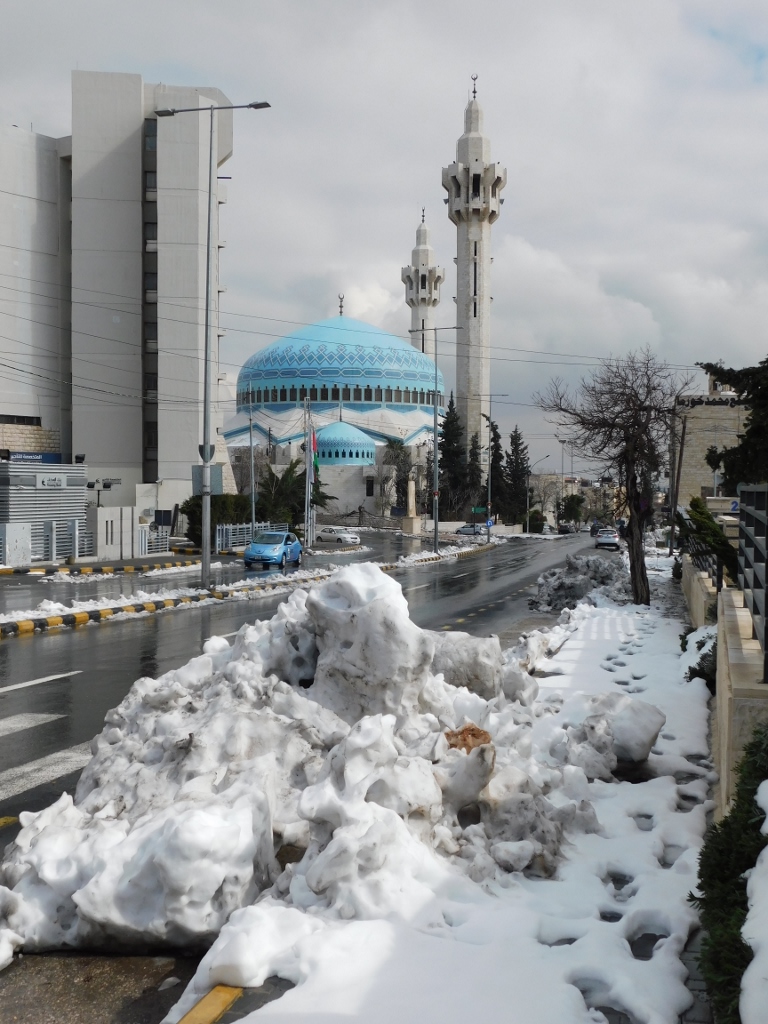 King Abdullah I Mosque
King Abdullah I Mosque
This is a mosque built by the late King Hussein of Jordan in honour of his grand-father, the first ruler of Jordan. The construction started in 1982 and was completed in 1989.
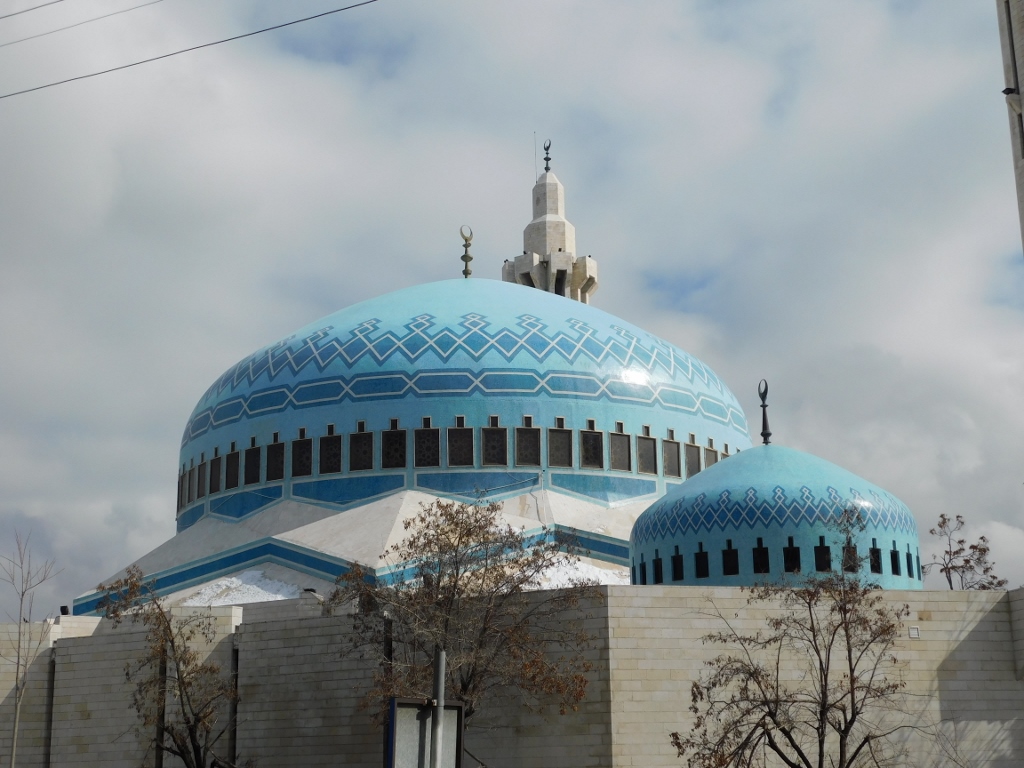 King Abdullah I Mosque
King Abdullah I Mosque
The mosque has two minarets and praying areas for 3000 believers. Tourist visits are permitted, but the visitors, of course, must be decently dressed.
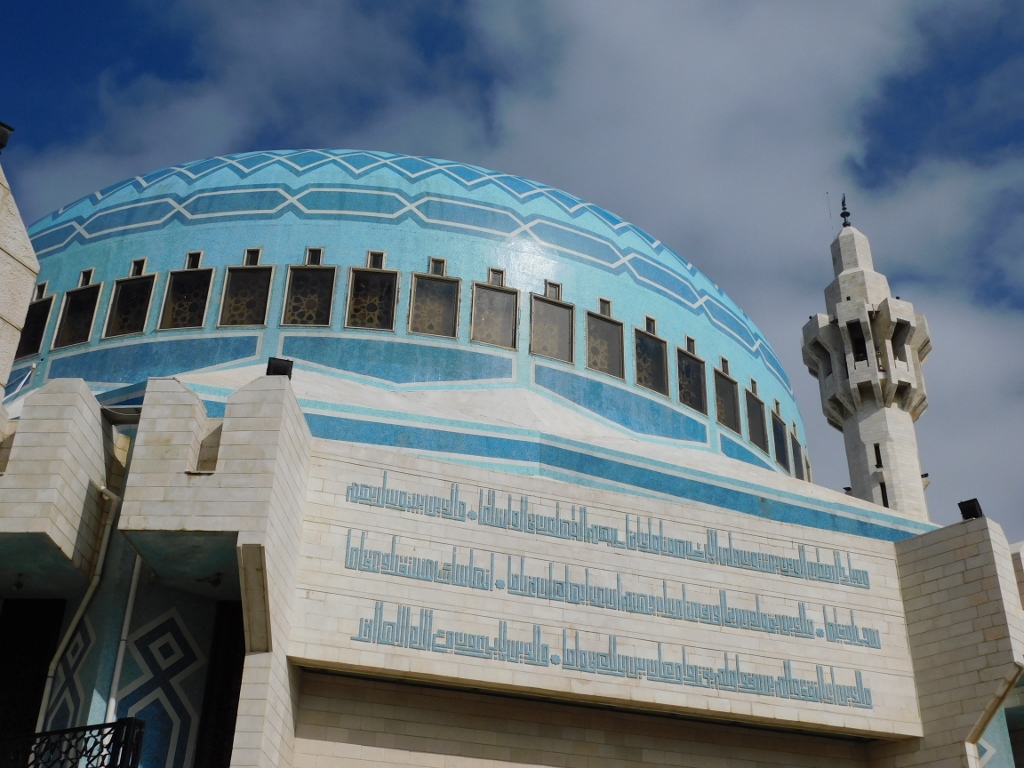 King Abdullah I Mosque
King Abdullah I Mosque
In order for the visitors to enter the mosque, it is necessary that they go to a special entrance and that also entails a passage through a practically large shop with souvenirs and Jordanian traditional crafts. One young woman greeted me there and said that I had to put over something like a thin and long female coat, an overgarment, because it was not enough that I had already completely covered my head with my scarf. Well, ok. The only problem was that I had my jacket and a backpack on, so I had to bother with that, but it eventually all went well.
The mosque is very impressive when you enter. This is a large hall with the ground plan in the shape of an eight-pointed star. Above the centre there is a dome that is 31 m high and has a diameter of 35 m. There are no pillars inside and the dome rests on the exterior walls of that central space.
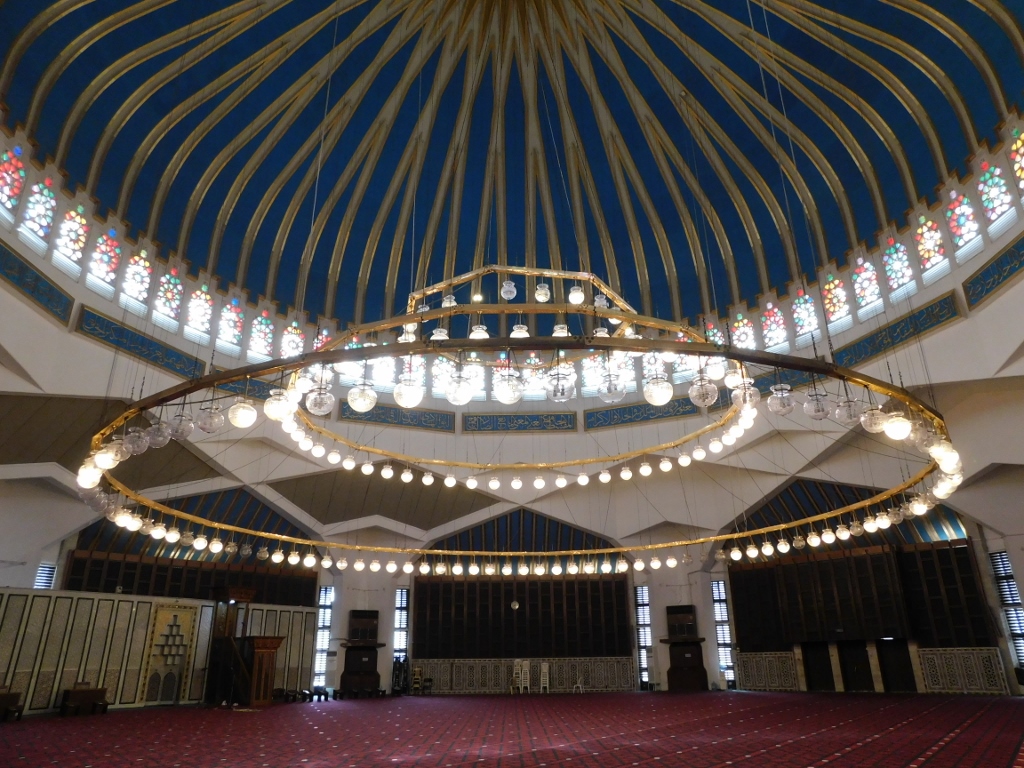 King Abdullah I Mosque, the interior
King Abdullah I Mosque, the interior
The interior of the mosque is full of hidden meanings and so the carpet is red because that symbolises the earth and the human plane of existence, while up, towards the dome, i.e., towards the sky, there are light bulbs as the source of light.
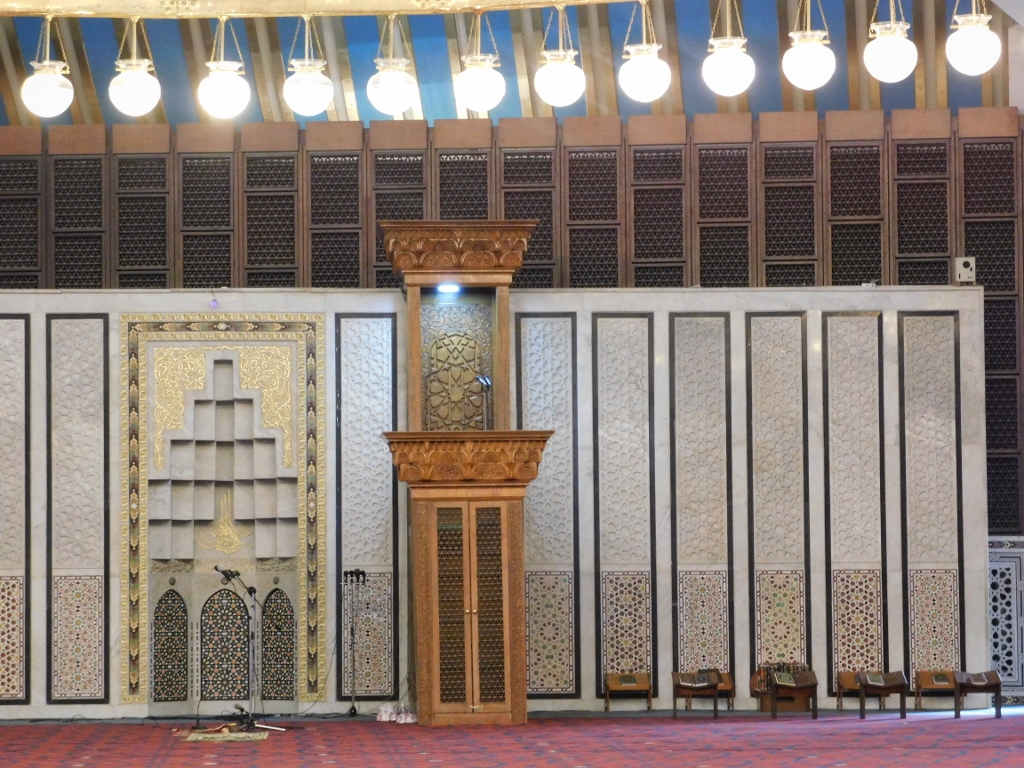 King Abdullah I Mosque, the mihrab and the minbar
King Abdullah I Mosque, the mihrab and the minbar
That girl who gave me the overgarment also told me that as a visitor I need to pay for a ticket, however, I did not see any place where I could buy it, nor anybody asked me anything. When after the visit to the mosque I returned to the souvenir shop and the girl, I gave her the overgarment back and told her that I did not pay anything, because I did not see any place where to do that, so then she laughed with her colleagues and said I was lucky. They also invited me to sit down with them and have some tea, but that was a part of the sales marketing, so I did not stay there for long.
Al Abdali is a part of Amman with a large number of commercial buildings and business facilities, but there are also residential segments. My plan now was to walk back to the downtown area where my hotel was and according to the map I could go again through the part of Amman called Lweibdeh, that is, I could walk via Jabal al Lweibdeh. I’m saying “again” since I visited that part of the city already at the beginning of my stay in Amman and Jordan.
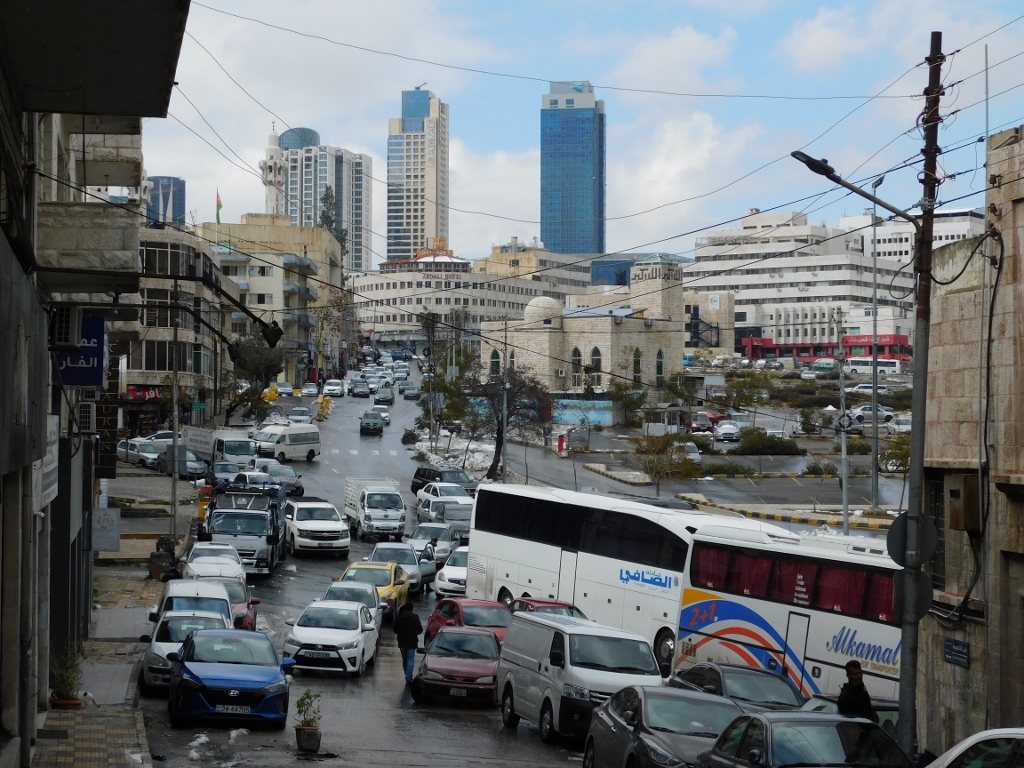 Leaving behind the part of the city with the King Abdullah I Mosque
Leaving behind the part of the city with the King Abdullah I Mosque
That area (again this is the summit of a hill) is well known for its large number of prominent cafés and restaurants. I did not make any stops there this time, but I enjoyed the walk and also felt glad that I could mostly move around without a map, which always makes me feel content because of the impression that I know my way around as if I were a local. Not quite, but this time my impression was significantly different (more relaxed) than the first time I came here.
Along the way, I could see numerous trees the branches of which had broken by the weight of the wet snow. Just like the people of Jordan, the trees were also (mostly) not ready for the snow.
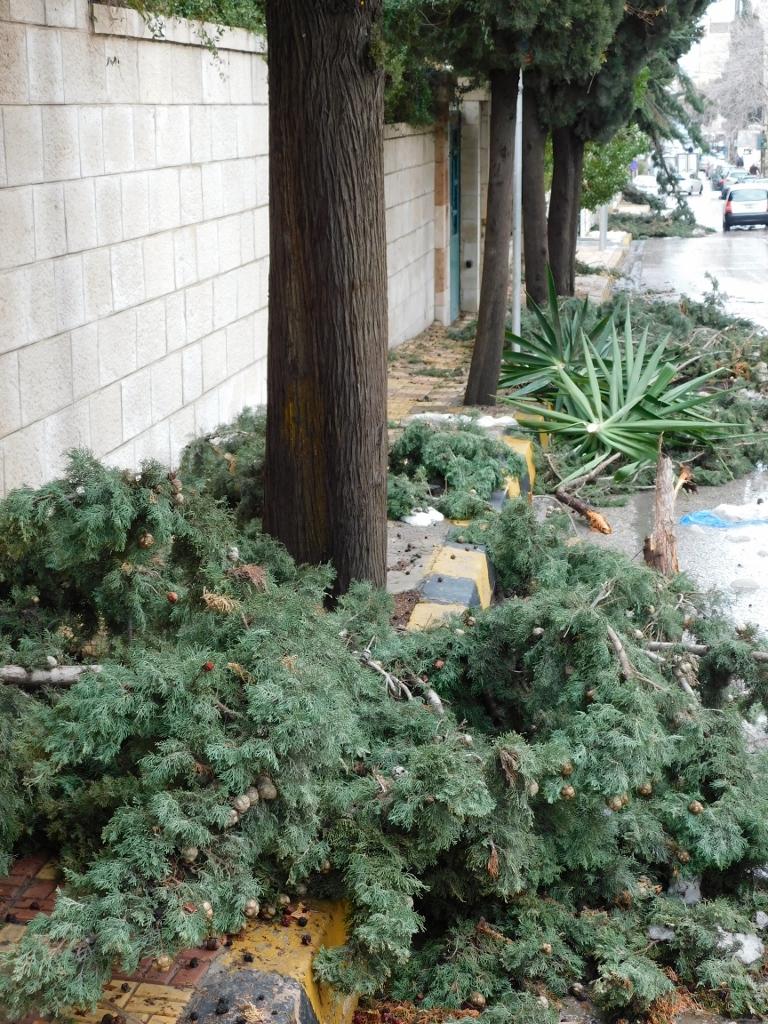 Broken branches
Broken branches
But, there were still some trees the branches and fruits of which did survive the recent snow.
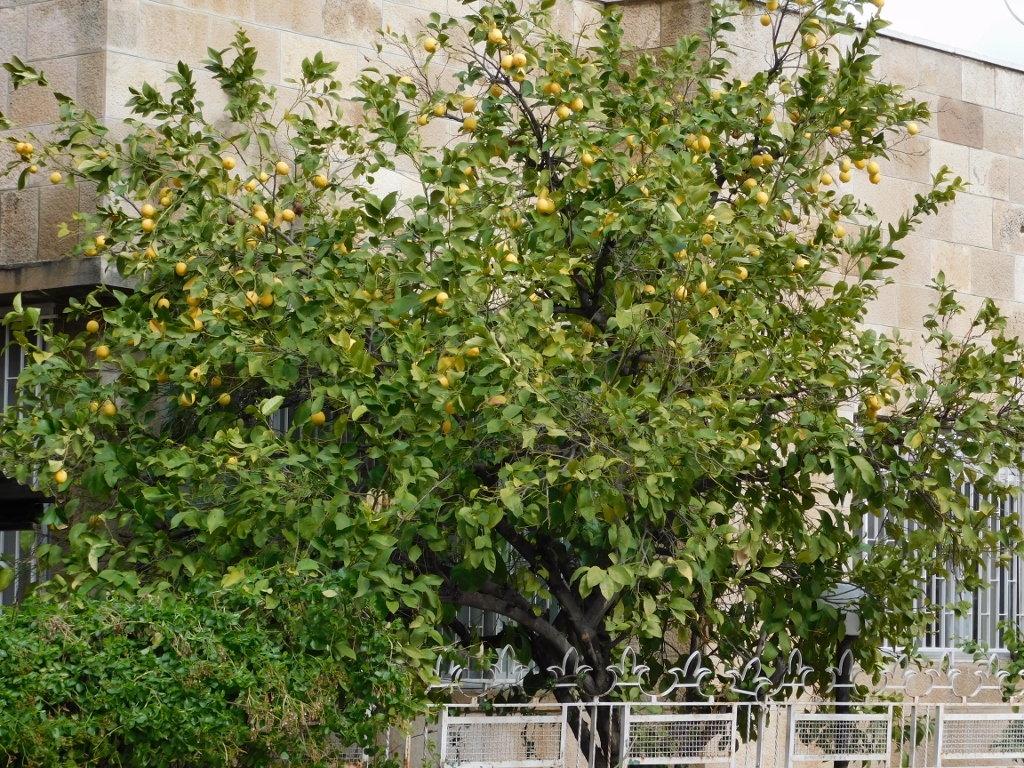 Lemon tree with fruits
Lemon tree with fruits
But, let there be no mistake, in addition to the cafés and restaurants, this quarter is also famous for its beautiful houses and art galleries. In line with that I passed by a house that belongs to Petra National Trust and I made a stop once more at Khalid Shoman Foundation.
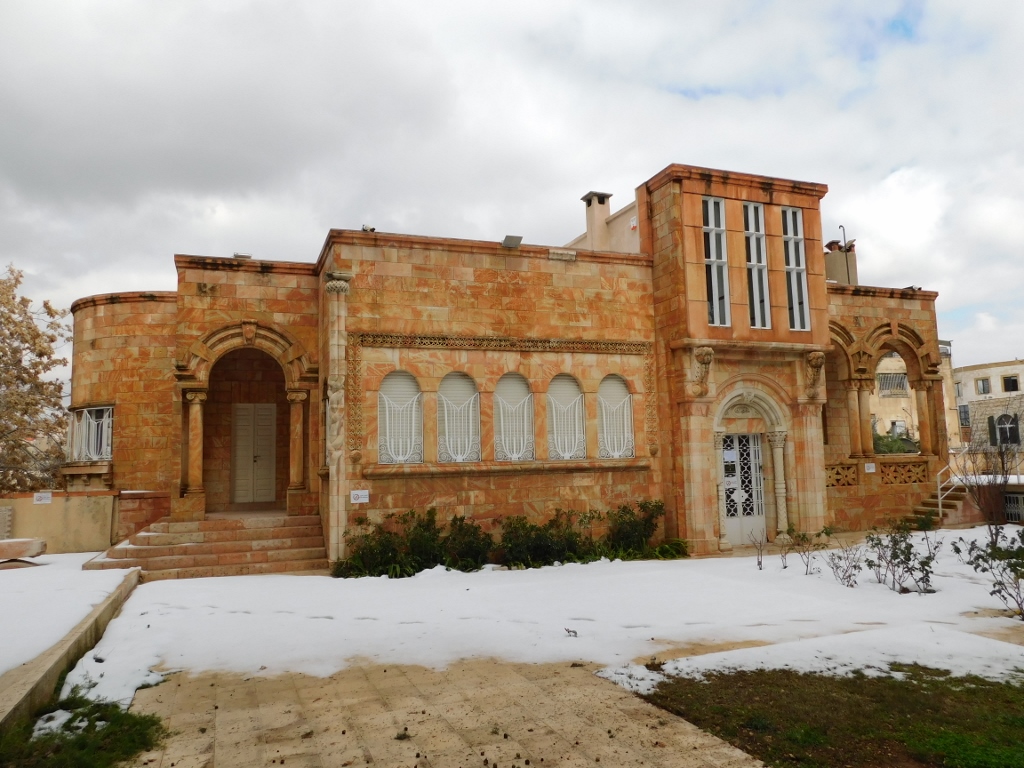 Petra National Trust
Petra National Trust
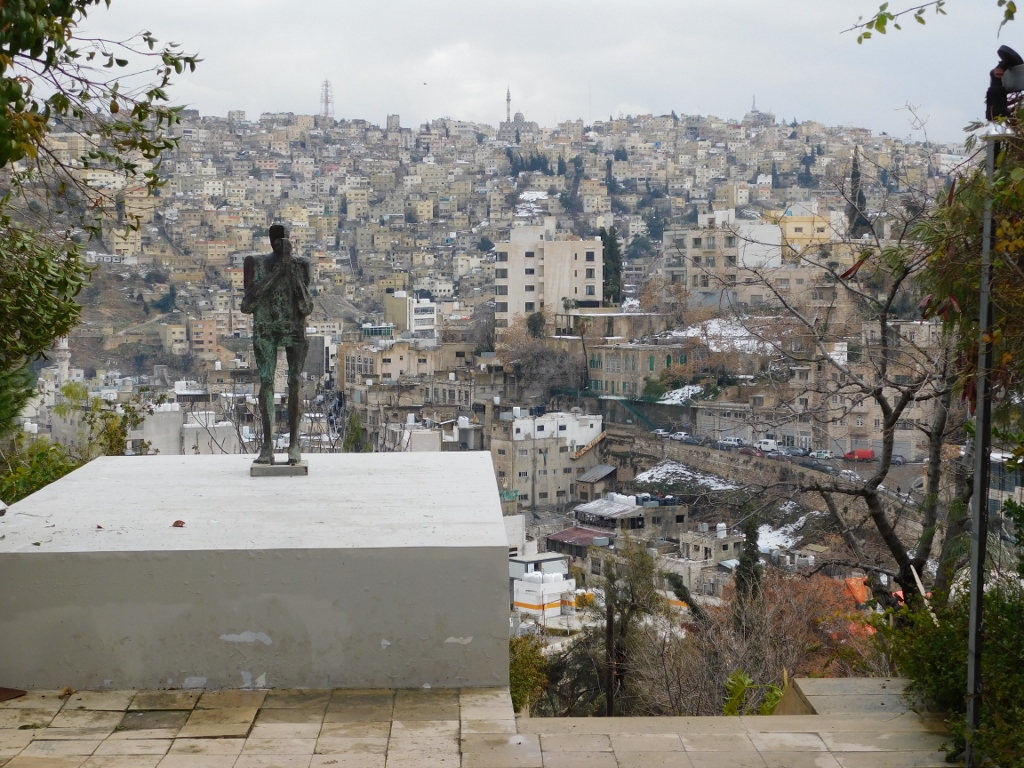 Khalid Shoman Foundation
Khalid Shoman Foundation
From here I leisurely went down to the centre of the city and there I had the fantastic freshly squeezed juice I have talked about. Yummy... it was a fantastic experience.
I also enjoyed the familiar sights from the area around the hotel at which I stayed – lots of shops, lots of different merchandise, lots of people... By thawing, the snow was becoming the thing of the past, while the Sun appeared through the clouds every now and then.
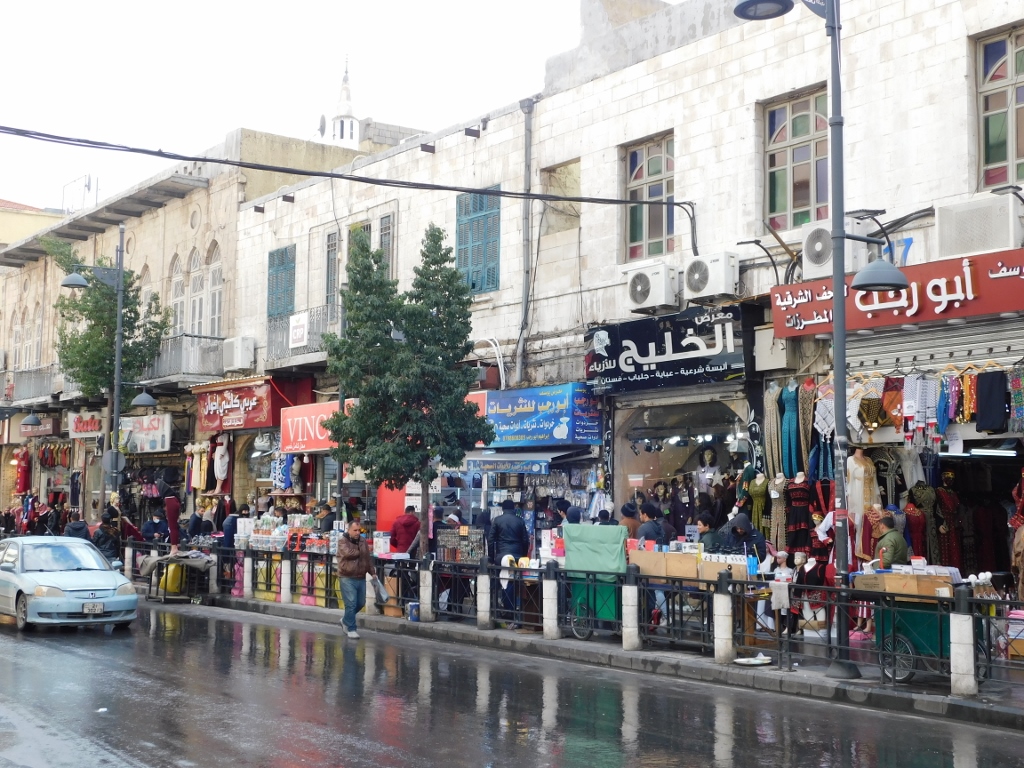 Downtown Amman
Downtown Amman
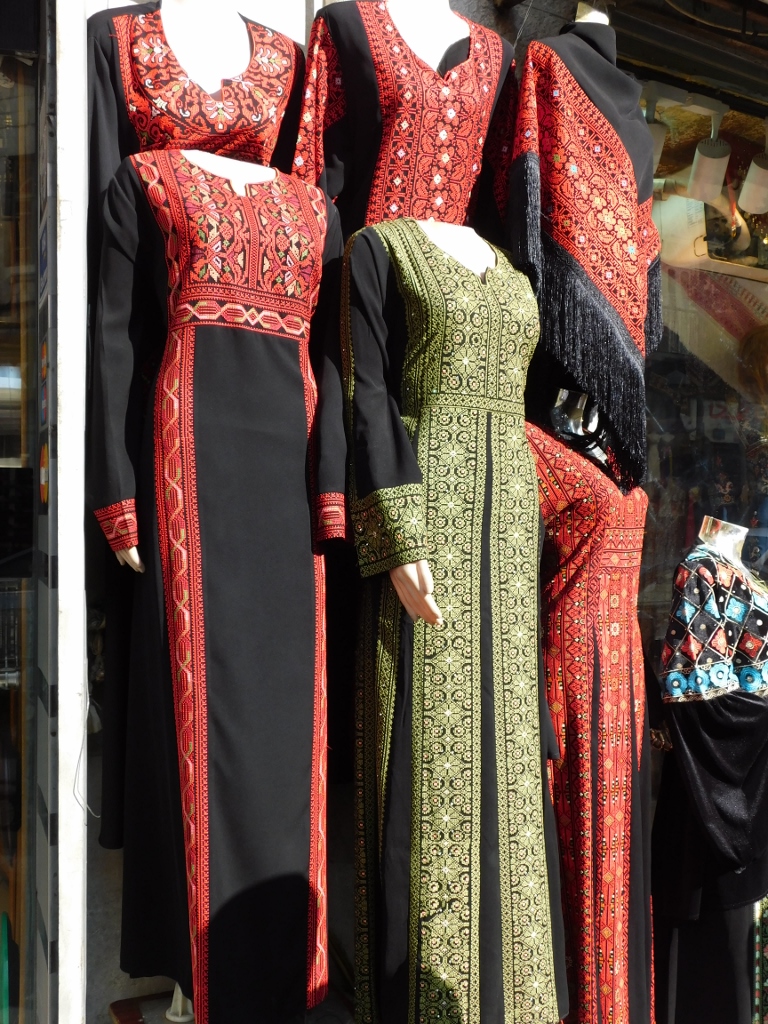 Beautiful embroidered dresses
Beautiful embroidered dresses
Then I also walked around a farmers’ market, mostly with fruits and vegetables, but also with milk products, which is actually located very close to my hotel and which for some odd reason I did not go to visit before. Like all the markets, this one also delighted me with its colours, different sights and the richness of fruits and produce.
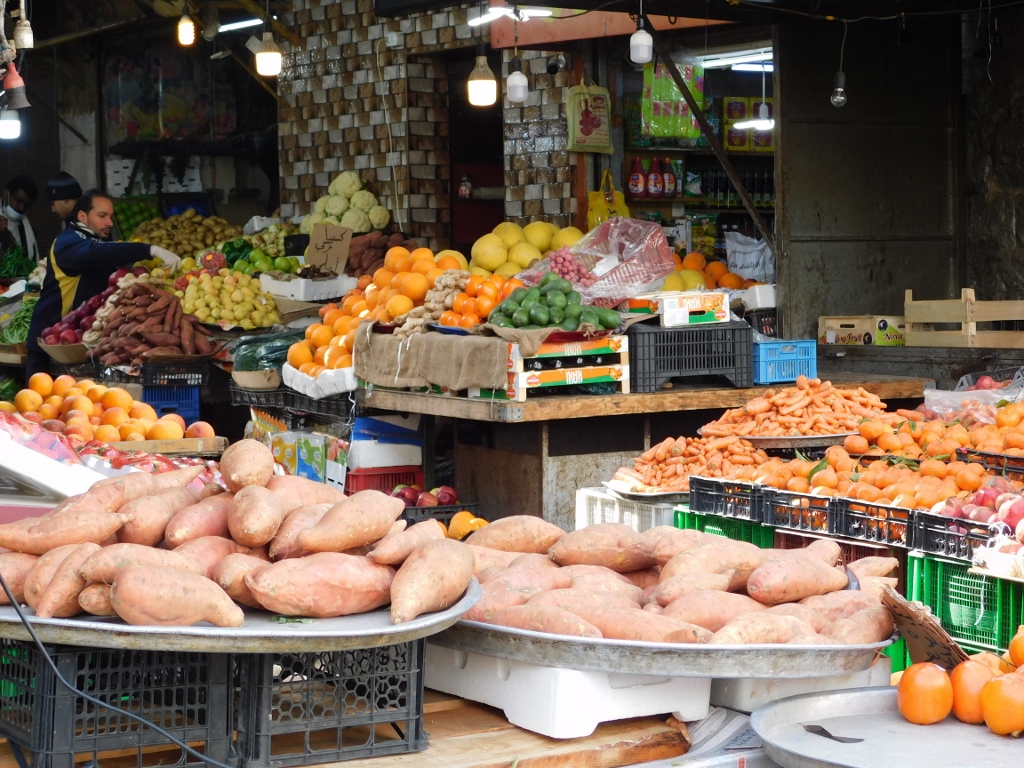 Farmers’ market in the downtown area of Amman
Farmers’ market in the downtown area of Amman
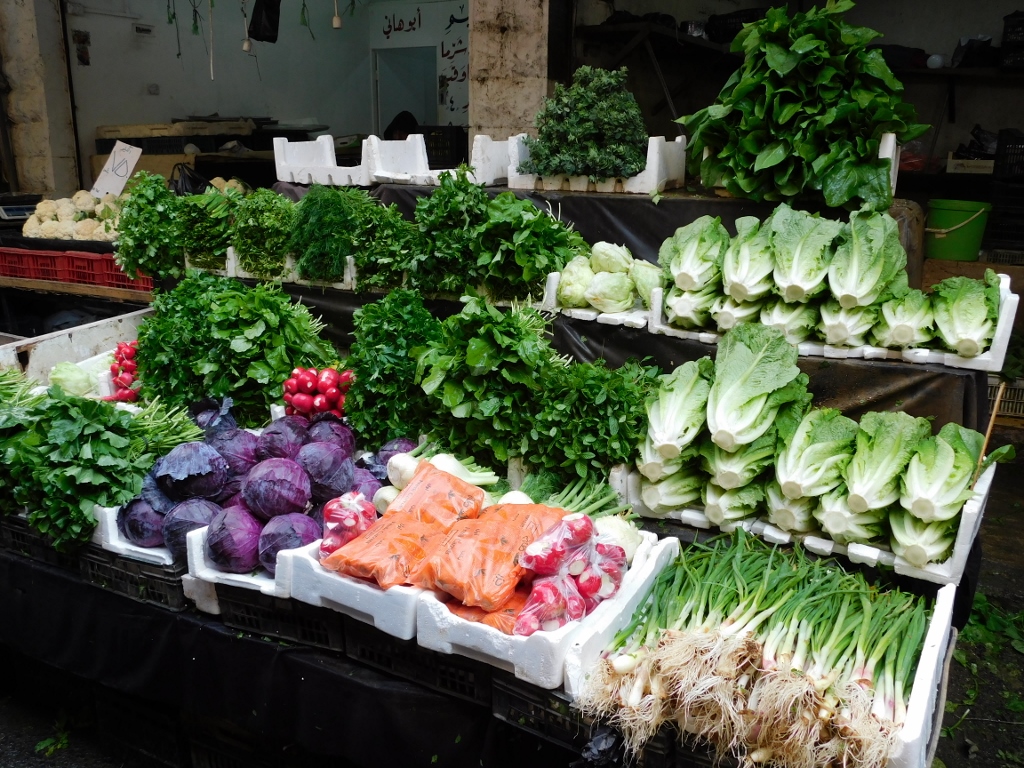 Farmers’ market in the downtown area of Amman
Farmers’ market in the downtown area of Amman
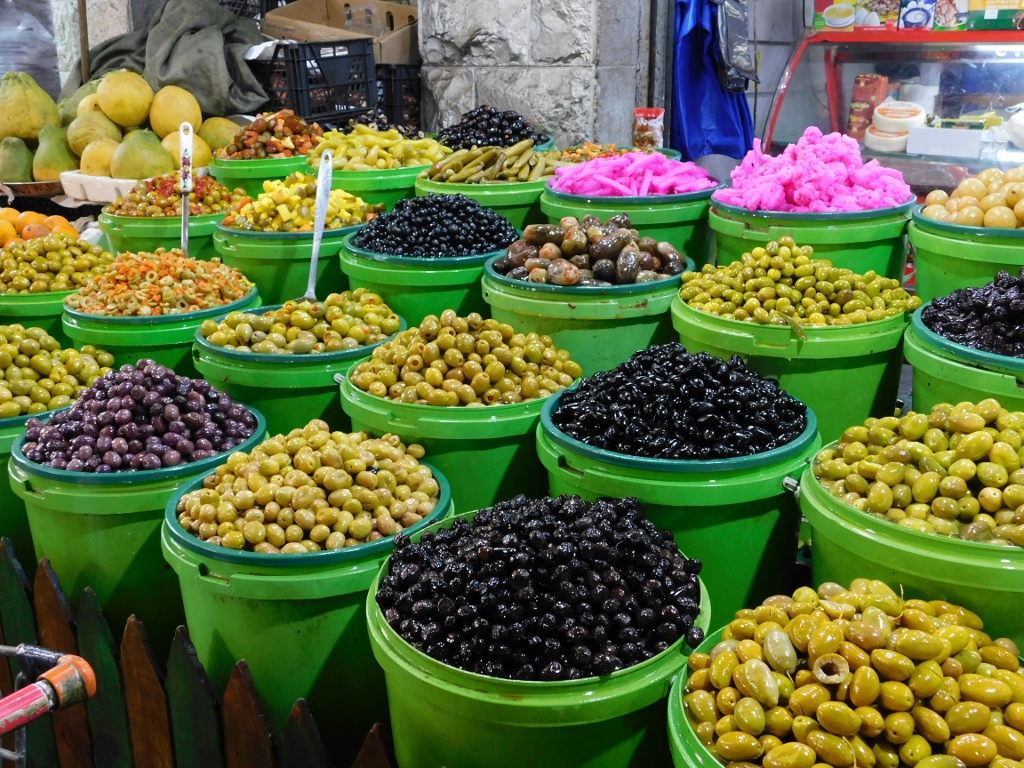 Farmers’ market in the downtown area of Amman
Farmers’ market in the downtown area of Amman
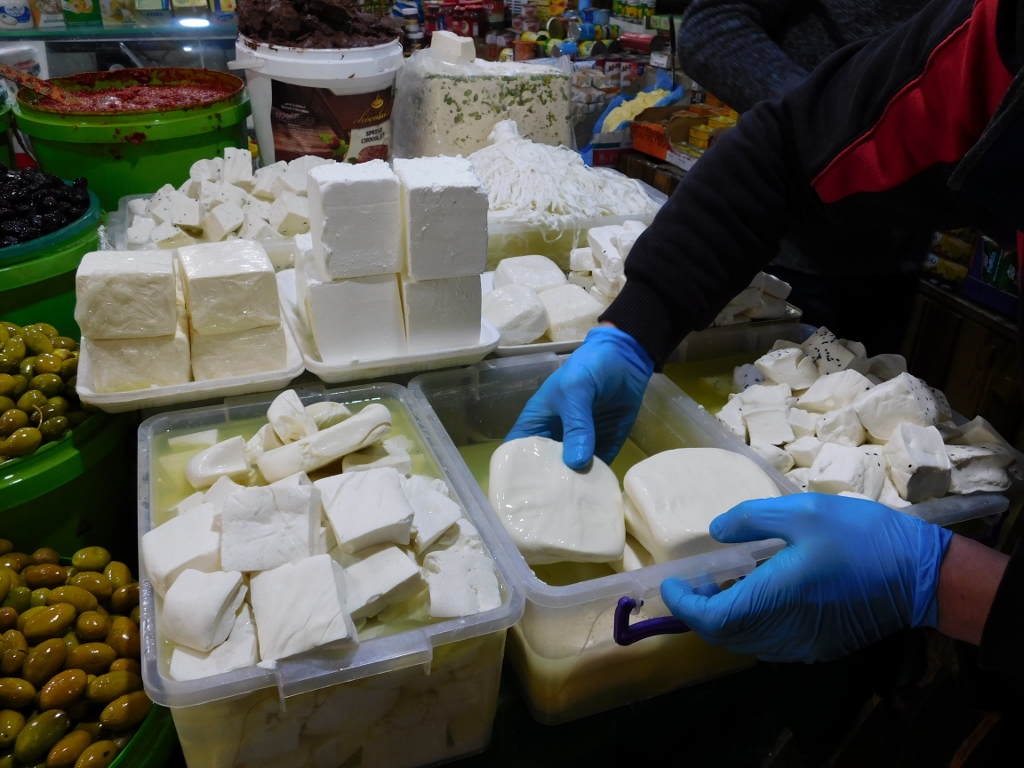 Farmers’ market in the downtown area of Amman
Farmers’ market in the downtown area of Amman
There were many things I knew and could recognise, but there were also some items that I was completely unfamiliar with. For instance, some smallish green pods.
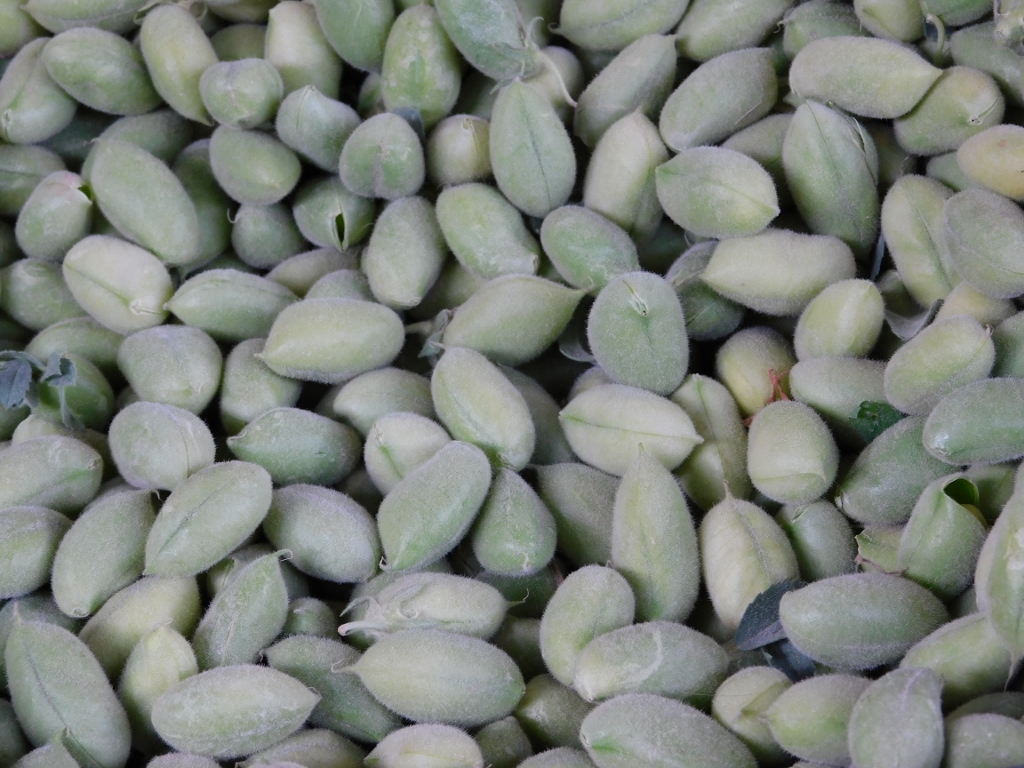 Novelty on the farmers’ market in downtown Amman
Novelty on the farmers’ market in downtown Amman
Then I asked a man what that was and he told me this was young chickpeas that could be eaten raw. He gave me one pod to try and it was quite tasty.
Then I went back to the hotel, primarily to unload the things I bought at the supermarket. I came across Farida and Anan (hotel staff) who were in the middle of their lunch break. They were having manakeesh, the local version of a pizza – thin crust with lots of melted cheese. They both invited me to sit down with them and share the lunch. Who was I to decline?
Since I agreed with Farida that after her obligations we would go together so that she could help me out with some small shopping, I left my things in the room and went out for a short walk to the nearby Roman Theatre.
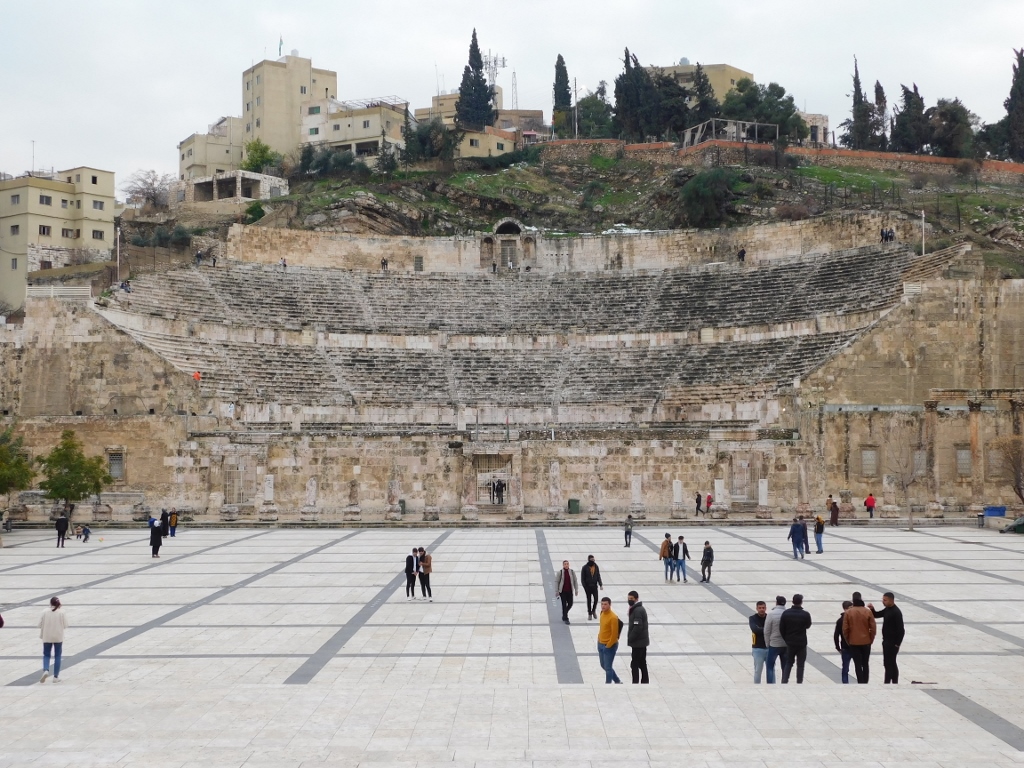 Roman Theatre in Amman
Roman Theatre in Amman
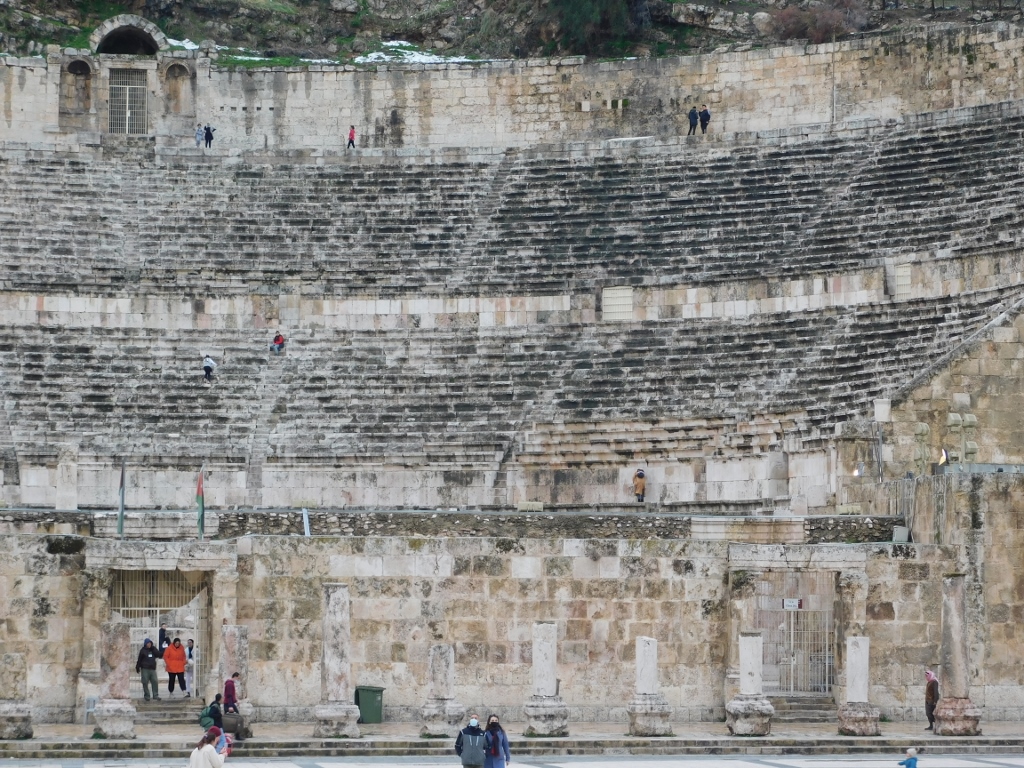 Roman Theatre in Amman, a detail
Roman Theatre in Amman, a detail
I was already there, at the beginning of my stay (https://www.svudapodji.com/jordan-6/), so I had no intention of buying a ticket again; I just wanted to take a few photos from the spacious plaza. Still, it was only this time that I noticed there was another, smaller theatre to the side, the Odeon, also from the Roman times, which I did not see the last time, so I peered a little. I explained to the guard that I had already been here, paying for the ticket, visiting the large theatre and the two smaller museums within the theatre area, so he let me in. I only briefly visited this small theatre and took a few photos.
 Odeon in Amman
Odeon in Amman
The Odeon is smaller than the Roman Theatre and it can hold around 500 spectators. The structure was made in the 2nd century CE and it is presumed that this edifice was used for the meetings of the city council. There was almost nobody inside this time around and so I played a little while making selfies. Please note the cap I crocheted back in Aqaba.
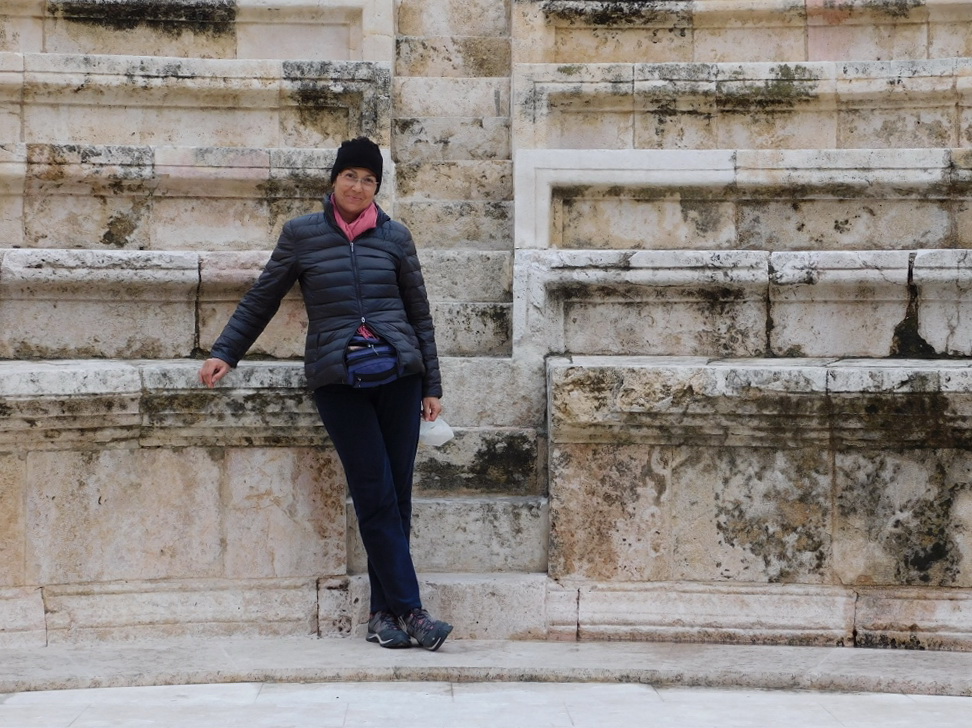 Selfie in Odeon with the new cap
Selfie in Odeon with the new cap
When I got out to the spacious plaza in front of the theatre, once again I looked up towards Jabal Al Qala’a, the hill on the top of which there are remains of the Citadel.
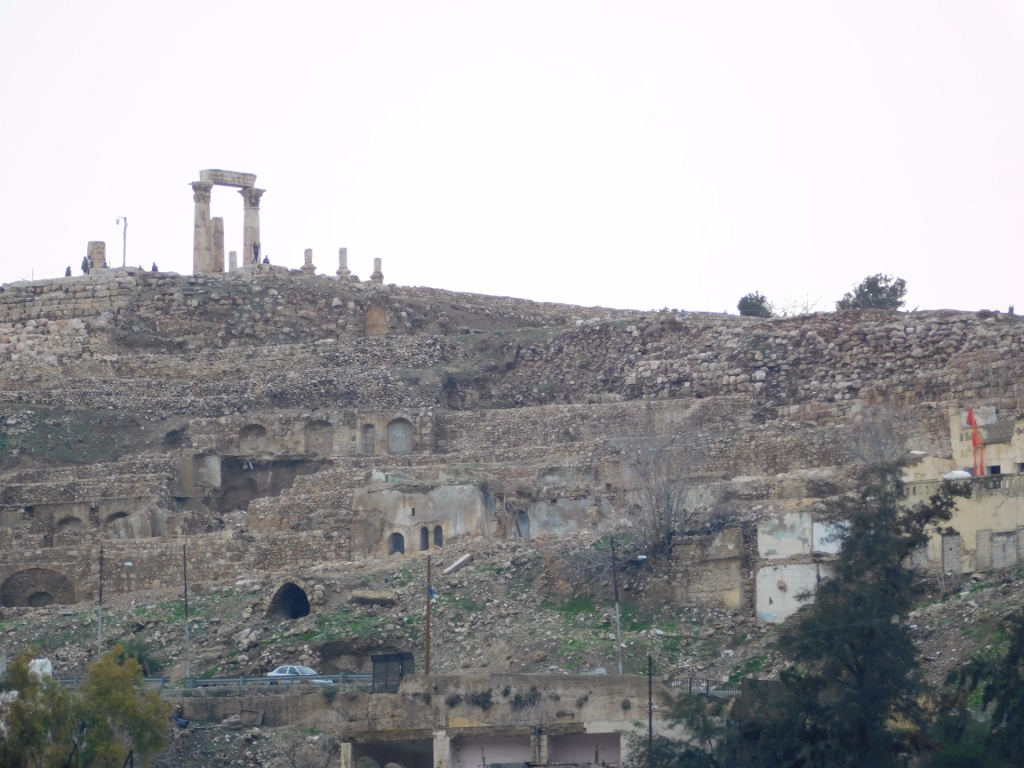 Citadel Hill – Jabal Al Qala’a
Citadel Hill – Jabal Al Qala’a
Generally speaking, this was a very relaxing afternoon that I spent walking leisurely around the neighbourhood, looking at different sights and taking photos. At one moment, the sunrays passed through the clouds.
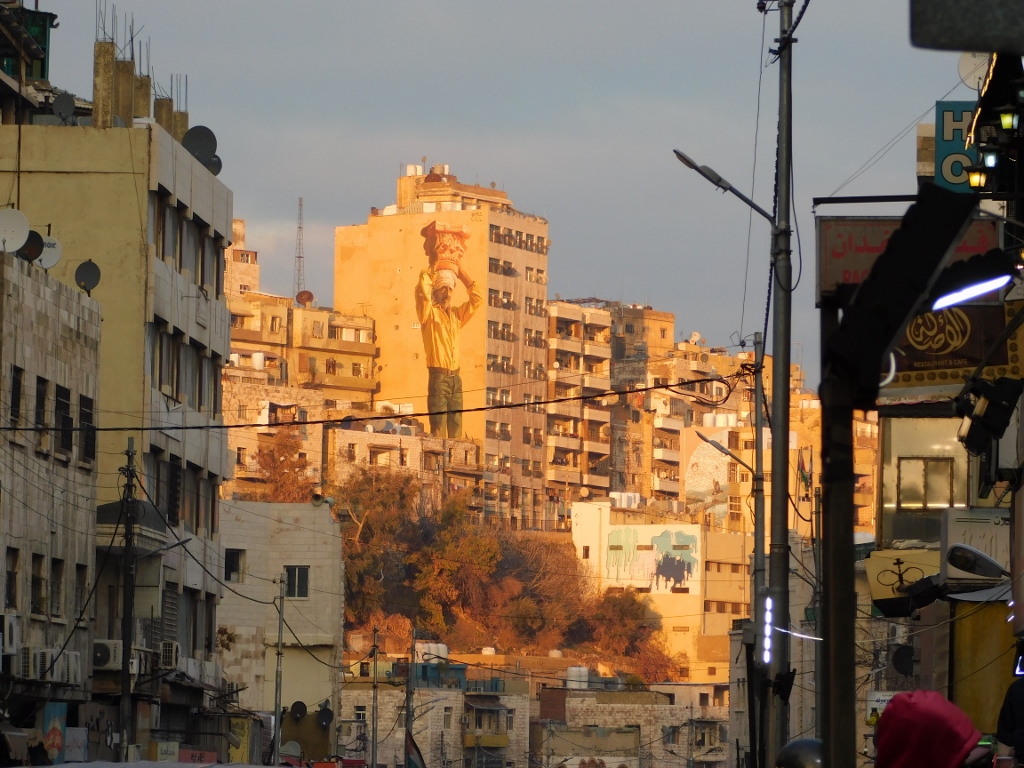 Amman, a detail
Amman, a detail
When I returned to the hotel a little later, I met up with Farida, but we were not alone. She had two friends of hers with her and then all four of us went to some shops near the farmers’ market so that I could buy some moulds for sweet that I wanted to make at home, as well as a few packs with freshly ground coffee beans. The reason why I needed the assistance with the purchase of coffee was that I liked the way the Jordanians made their Turkish coffee (almost like in Serbia), with the difference that they added cardamom to their coffee. In some places, they add small cardamom pods while brewing coffee and in some other places ground cardamom is added to the roasted coffee beans just before grinding them. The latter was the case with the coffee that I bought as present for some of my friends. This was certainly one of the typical tastes (and scents) of Jordan and as far as I understood one had to go to specialised shops in order to get this mixture. I was grateful to Farida for her help.
When I finished with what I wanted to do, we all went to a café where we continued hanging out for a while. Although the communication was very limited (Farida spoke some English, but her friends did not), it was fun nonetheless and it was certainly pleasant.
After this, Farida and I went back to the hotel and I could now pack up my things completely and get ready for the return trip the following day.
The next morning I woke up early, as I usually do during my trips, and then I went for breakfast. Again, at the end, I had my cup of Turkish coffee in the company of Farida and again that was a most pleasant experience, but by this time I had to go. At the reception, I cordially parted from Jumma and was picked up by Ali, one of the drivers that took me to an excursion at the beginning of my stay in Amman. It was truly as if I was parting, if not from friends, than at least from very good acquaintances.
And it was as if Amman and Jordan wanted to invite me to go back as soon as possible – the day was gloriously sunny, everything was freshly washed by the snow of a couple of days earlier and with my face almost stuck to the car window I was bidding farewell to this fabulous city and this stunning country filled with fantastic people and an incredible quantity of cultural, historical and natural beauty.
Here is also the map that shows all the places I visited and wrote about in my travel stories about Jordan.